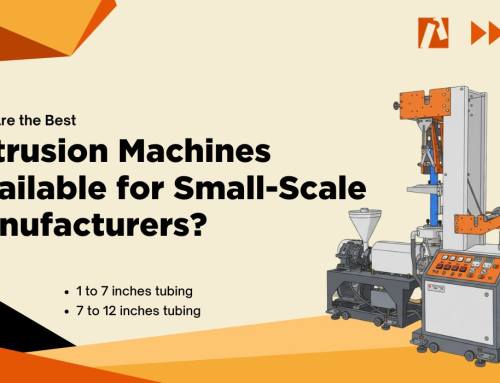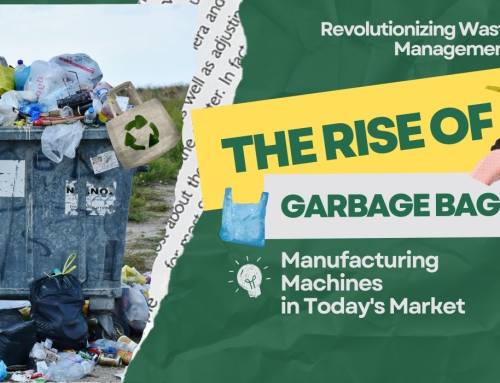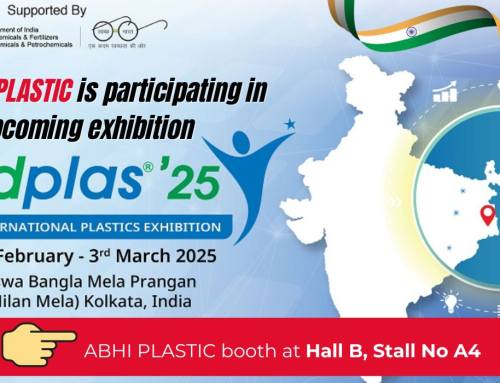Looking to skyrocket productivity in your manufacturing process? Look no further than harnessing the power of plastic extrusion machines. In this comprehensive guide, we unveil the secrets to maximizing efficiency and output with these cutting-edge tools. From enhancing workflow to optimizing output, we’ve got you covered.
Whether you’re a seasoned professional or just diving into the world of plastic manufacturing, our step-by-step strategies and expert tips will propel your productivity to new heights. Discover how to fine-tune your operations, streamline your production line, and elevate your results with the latest in plastic extrusion technology.
Get ready to revolutionize your manufacturing process and achieve unparalleled efficiency with our ultimate guide to boosting productivity with plastic extrusion machines. Say goodbye to inefficiencies and hello to enhanced output and profitability.
How Plastic Extrusion Machines Work
Plastic extrusion machines are vital tools in the manufacturing sector, primarily used for shaping plastic materials into desired forms. These machines operate by melting plastic pellets and forcing them through a die, which shapes the material into continuous profiles such as sheets, tubes, and rods. The process starts with the feeding of plastic granules into a heated barrel where they are gradually melted by a combination of heat and mechanical shear from a rotating screw. As the molten plastic moves along the barrel, it is cooled and solidified once it exits through the die, forming the final product.
This entire sequence is controlled by precise temperature settings and pressure management, ensuring the quality and consistency of the extruded materials. The choice of die determines the shape and size of the extruded product. Once the plastic exits the die, it can undergo further cooling, cutting, or winding processes, depending on the end application. The efficiency of this entire system hinges on the machine’s design and the parameters set for various production runs, making it essential for manufacturers to have a deep understanding of how these machines function.
Understanding the intricacies of plastic extrusion allows for improved efficiency and output. By mastering the operational aspects, manufacturers can identify potential bottlenecks and make necessary adjustments to streamline the process. This knowledge is crucial for optimizing productivity, as even minor modifications in parameters can lead to significant enhancements in production rates and quality.
Advantages of Using Plastic Extrusion Machines
The utilization of plastic extrusion machines comes with a host of advantages that significantly enhance the productivity of manufacturing processes. One of the primary benefits is the ability to produce complex shapes with high precision and consistency. Unlike other manufacturing methods, extrusion allows for continuous production, which means that manufacturers can create long lengths of material without interruptions. This continuous flow not only reduces waste but also minimizes the time spent on setup and changeovers, increasing overall throughput.
Another compelling advantage of plastic extrusion is its versatility. These machines can process a wide range of thermoplastics, enabling manufacturers to tailor their products to meet specific market demands. Whether it’s creating custom profiles for construction applications or producing specialized packaging materials, extrusion can accommodate diverse requirements. Moreover, the ability to blend additives into the plastic during the extrusion process enhances the material’s properties, leading to products with improved strength, flexibility, and durability.
Cost-effectiveness is also a significant factor that makes plastic extrusion machines appealing. The initial investment in high-quality extrusion equipment can yield substantial returns through increased efficiency and reduced labor costs. As the machines operate continuously, the cost per unit of production decreases, allowing manufacturers to offer competitive pricing while maintaining healthy profit margins. Additionally, the scalability of extrusion processes enables businesses to adjust production levels based on market trends without incurring excessive costs.
Factors Affecting Productivity in Plastic Extrusion
Several factors play a crucial role in determining the productivity levels of plastic extrusion processes. One of the most significant is the temperature control throughout the extrusion process. Properly managing the temperature of the melt is essential, as it affects the viscosity of the plastic material. If the temperature is too low, the material may not flow correctly, leading to defects; conversely, excessive heat can degrade the plastic, impacting the final product’s quality. Maintaining optimal temperature settings is key to achieving consistent output and minimizing downtime due to material issues.
Machine speed and feed rate are also critical factors that influence productivity. The speed at which the extrusion machine operates directly correlates with the output volume; however, it’s essential to find the right balance. If the feed rate exceeds the machine’s capacity to melt and process the material, it can lead to blockages and a decrease in quality. Conversely, operating at too low of a speed can result in inefficiencies and wasted time. Thus, understanding the machine’s specifications and capabilities is vital for optimizing production rates.
Lastly, the design and condition of the die used in the extrusion process significantly impact productivity. A well-designed die ensures uniform flow and minimizes pressure drop, allowing for a smooth extrusion process. Regular maintenance of the die is essential to prevent wear and tear, which can lead to inconsistencies in product quality and increased production time. Therefore, focusing on these factors can help manufacturers enhance their plastic extrusion productivity and achieve better outcomes in their operations.
Tips for Optimizing Productivity with Plastic Extrusion Machines
To maximize productivity with plastic extrusion machines, manufacturers should consider implementing a series of best practices. First and foremost, regular maintenance and calibration of the machinery are essential. Scheduled inspections help identify wear and tear early, preventing costly breakdowns and production delays. Routine checks on temperature settings, screw speed, and die conditions can ensure that the machines operate at peak efficiency, ultimately leading to a smoother production process and higher output rates.
Another effective strategy is to invest in operator training. Skilled operators are critical to the success of the extrusion process. Providing comprehensive training on machine operation, troubleshooting, and maintenance can empower operators to identify and resolve issues swiftly, minimizing downtime. Furthermore, well-informed operators can make informed decisions regarding adjustments to parameters based on real-time observations, leading to improved quality and efficiency.
Collaboration with suppliers to select the right materials is also vital for optimizing productivity. Different types of plastics have unique processing requirements, and choosing the appropriate material can greatly affect production speed and product quality. Suppliers can offer insights into material properties and help manufacturers select options that align with their production goals. By ensuring compatibility between materials and machines, manufacturers can enhance their extrusion processes and achieve better overall productivity.
Common Challenges in Plastic Extrusion Productivity
Despite the many advantages of plastic extrusion, manufacturers often encounter challenges that can hinder productivity. One common issue is material variability. Fluctuations in the quality or composition of raw materials can lead to inconsistencies in the extruded product. Such variability often results in defects, increased scrap rates, and production delays. To mitigate these risks, manufacturers should establish strong relationships with reliable suppliers and implement rigorous quality control measures to ensure that only high-quality materials are used in the extrusion process.
Another challenge is the complexity of managing multiple production runs and product variations. As market demands shift, manufacturers may need to switch between different products, each requiring distinct settings and parameters. This transition can lead to inefficiencies, especially if the process for changing dies or recalibrating machines is not well-defined. To overcome this hurdle, manufacturers can develop standardized operating procedures for quick changeovers, thereby reducing setup times and enhancing overall productivity.
Lastly, equipment limitations can also pose significant challenges to productivity. Older machines may not have the capabilities or automation features found in newer models, resulting in slower production rates and higher labor costs. Investing in modern extrusion technology can alleviate these issues, providing manufacturers with the tools needed to keep up with industry demands. By continuously evaluating equipment performance and upgrading when necessary, manufacturers can maintain a competitive edge and ensure high productivity levels.
Maintenance and Care of Plastic Extrusion Machines
Proper maintenance and care of plastic extrusion machines are vital for ensuring consistent productivity and longevity of the equipment. Regular maintenance schedules should be established, including daily, weekly, and monthly checks. Daily inspections might include monitoring temperature settings, screw wear, and cleaning the feed throat to prevent material buildup. Weekly checks could involve examining the die for any signs of wear and tear, while monthly maintenance should focus on more comprehensive tasks such as lubrication and replacing worn components.
It’s also essential to keep detailed maintenance records. Documenting maintenance activities not only helps track the machine’s performance but also allows manufacturers to identify recurring issues and address them proactively. This practice aids in planning future maintenance tasks and budgeting for necessary repairs or replacements. By maintaining a well-documented history of machine care, manufacturers can enhance their operational efficiency and reduce the risk of unexpected breakdowns.
Additionally, operators should be trained to perform routine maintenance tasks. Empowering operators with the knowledge and skills to handle basic maintenance allows for quicker identification of problems before they escalate into major issues. Operator-led maintenance initiatives can lead to a culture of care and responsibility, ultimately fostering an environment where productivity is prioritized. Regular communication between operators and maintenance personnel can also ensure that any concerns are addressed promptly and efficiently.
Innovations in Plastic Extrusion Technology
The plastic extrusion industry is continually evolving, thanks to technological advancements that enhance productivity and efficiency. One notable innovation is the integration of Industry 4.0 principles, which utilize smart technology and data analytics to optimize production processes. By incorporating sensors and IoT devices, manufacturers can monitor machine performance in real-time, gaining insights into operational efficiency. This data-driven approach allows for predictive maintenance and informed decision-making, ultimately leading to reduced downtime and improved productivity.
Another significant development is the advancement of extrusion technologies such as co-extrusion and multi-layer extrusion. These processes enable manufacturers to create products with multiple layers, each serving a distinct purpose, such as improved barrier properties or enhanced aesthetics. This capability not only diversifies product offerings but also addresses growing consumer demands for specialized materials. By leveraging these advanced techniques, manufacturers can capitalize on new market opportunities while maintaining high production efficiency.
Sustainability is also becoming a driving force in plastic extrusion innovations. The industry is increasingly focusing on recycling and the use of biodegradable plastics. Innovations such as recycling-friendly extrusion processes allow manufacturers to repurpose plastic waste into new products, contributing to a circular economy. By adopting sustainable practices and materials, manufacturers can improve their environmental footprint while also appealing to a more eco-conscious consumer base, merging productivity with social responsibility.
Training and Certification for Plastic Extrusion Machine Operators
Effective training and certification programs for plastic extrusion machine operators are essential for maximizing productivity and ensuring safety in the manufacturing environment. A comprehensive training initiative should cover not only the technical aspects of operating the machinery but also the importance of safety protocols and best practices. New operators should undergo hands-on training that includes familiarization with the machine’s components, understanding operational procedures, and learning how to troubleshoot common issues.
Certification programs can further enhance the skills of operators by providing them with recognized credentials that demonstrate their expertise. These programs often include assessments that test the operator’s knowledge of extrusion processes, safety measures, and maintenance practices. Certified operators are more likely to perform efficiently and effectively, minimizing the risk of accidents and production errors. Investing in operator education not only boosts individual performance but also contributes to the overall productivity of the manufacturing facility.
Additionally, ongoing training opportunities should be provided to keep operators updated on the latest technology and industry trends. Continuous professional development helps operators adapt to evolving production techniques and machinery upgrades, ensuring that they remain valuable assets to the organization. By fostering a culture of learning and improvement, manufacturers can empower their workforce, leading to enhanced productivity and job satisfaction.
Conclusion and Future Trends in the Plastic Extrusion Industry
As the plastic extrusion industry continues to evolve, manufacturers must remain adaptable to emerging trends and technologies to boost productivity. The growing focus on sustainability is likely to shape future developments, with an emphasis on recycling and the use of eco-friendly materials. Manufacturers who embrace these changes can not only improve their operational efficiency but also align with consumer preferences for sustainable products.
Moreover, advancements in automation and smart manufacturing will play a crucial role in the future of plastic extrusion. The integration of artificial intelligence and data analytics will enable manufacturers to optimize their processes further, leading to reduced waste and improved product quality. As these technologies become more accessible, companies that invest in automation will likely gain a competitive advantage in the marketplace.
In conclusion, the plastic extrusion industry is poised for significant growth and transformation in the coming years. By focusing on operator training, machine maintenance, and adopting innovative technologies, manufacturers can enhance their productivity and position themselves as leaders in the industry. With a commitment to continuous improvement and adaptation, the future of plastic extrusion holds great promise for those willing to embrace change.








Leave A Comment